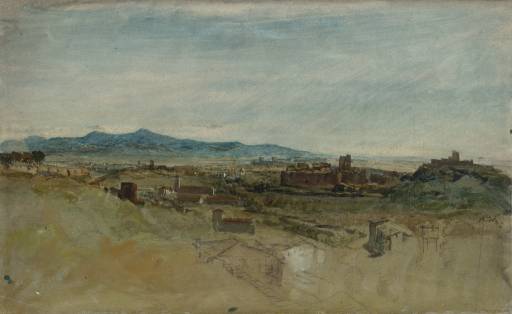Joseph Mallord William Turner View of the Baths of Caracalla, from the Palatine Hill, Rome 1819
Joseph Mallord William Turner,
View of the Baths of Caracalla, from the Palatine Hill, Rome
1819
Joseph Mallord William Turner 1775–1851
View of the Baths of Caracalla, from the Palatine Hill, Rome 1819
D16334
Turner Bequest CLXXXIX 8
Turner Bequest CLXXXIX 8
Pencil, pen and ink, watercolour, gouache and grey watercolour wash on white wove ‘Whatman’ paper 227 x 368 mm
Stamped in black ‘CLXXXIX 8’ bottom right
Stamped in black ‘CLXXXIX 8’ bottom right
Accepted by the nation as part of the Turner Bequest 1856
Exhibition history
1904
National Gallery, London, various dates to at least 1904 (260).
1937
Watercolours from the Turner Bequest, Gloucester, May–July 1937 (no catalogue).
1974
Turner 1775–1851, Royal Academy, London, November 1974–March 1975 (222, as ‘Rome: the Baths of Caracalla from the Aventine’ [incorrectly as CLXXIX 8]).
1983
J.M.W. Turner: Dibujos y acuarelas del Museo Británico, exhibition catalogue, Museo del Prado, Madrid, February–March 1983 (28, reproduced in colour).
1986
Turner Exhibition, National Musuem of Western Art, Tokyo, August–October 1986, Municipal Museum of Art, Kyoto, October–November 1986 (73, reproduced in colour).
1990
The Third Decade: Turner Watercolours 1810–1820, Tate Gallery, London, January–April 1990 (39, reproduced).
1998
J.M.W. Turner: “That Greatest of Landscape Painters”: Watercolors from London Museums, Philbrook Museum of Art, Tulsa, February–April 1998 (20, reproduced in colour).
References
1879
Philip Gilbert Hamerton, The Life of J. M. W. Turner, R.A., London 1879, p.186, as ‘Rome; the Alban Mount’.
1904
E.T. Cook and Alexander Wedderburn (eds.), Library Edition: The Works of John Ruskin: Volume XIII: Turner: The Harbours of England; Catalogues and Notes, London 1904, no.260, pp.378, 622, as ‘The Alban Mount’.
1909
A.J. Finberg, A Complete Inventory of the Drawings of the Turner Bequest, London 1909, vol.I, p.562, as ‘The Alban Mount. Water colour. 260, N.G.’.
1920
D[ugald] S[utherland] MacColl, National Gallery, Millbank: Catalogue: Turner Collection, London 1920, p.87.
1925
Thomas Ashby, Turner’s Visions of Rome, London and New York 1925, p.27, reproduced in colour between pp.22–23 pl.21, as ‘The Alban Mount’.
1974
Martin Butlin, Andrew Wilton and John Gage, Turner 1775–1851, exhibition catalogue, Royal Academy, London 1974, no.222, p.88, as ‘Rome: the Baths of Caracalla from the Aventine’ [incorrectly as CLXXIX 8].
1983
Lindsay Stainton and Andrew Wilton, J.M.W. Turner: Dibujos y acuarelas del Museo Británico, exhibition catalogue, Museo del Prado, Madrid 1983, no.28, pp.49–50, reproduced in colour, p.[48], as ‘Roma: las Termas de Caracalla desde el Palatino’.
1986
Haruki Yaegashi, Martin Butlin, Evelyn Joll and others, Turner Exhibition, exhibition catalogue, National Musuem of Western Art, Tokyo 1986, no.73, p.192, reproduced in colour, as ‘Rome: The Baths of Caracalla from the Palatine’.
1987
Andrew Wilton, Turner Watercolours in the Clore Gallery, London 1987, reproduced in colour, p.81 pl.33, as ‘Rome from the Baths of Caracalla’.
1990
Diane Perkins, The Third Decade: Turner Watercolours 1810–1820, exhibition catalogue, Tate Gallery, London 1990, no.39 reproduced, as ‘Rome from the Baths of Caracalla’.
1998
Richard P. Townsend, Andrew Wilton, David Blayney Brown and others, J.M.W. Turner: “That Greatest of Landscape Painters”: Watercolors from London Museums, exhibition catalogue, Philbrook Museum of Art, Tulsa 1998, no.20, as ‘Rome: The Baths of Caracalla from the Aventine’, pp.7, 25, 38, 62, 114, reproduced in colour, pp.28, 115 [incorrectly referenced and reproduced throughout as CLXXXIX 27, ‘Rome from the Apennines’].
The Palatine Hill was one of the most popular vantage points in Rome and Turner made a large number of studies from the location, recording prospects of the city seen in all directions. This coloured study depicts the view looking south-east towards the Baths of Caracalla, a large ruined complex of ‘thermae’, or public baths dating from 206 AD.1 On an area of high ground to the right of the Baths can be seen the Church of Santa Balbina on the Aventine Hill, whilst in the distance to the left is the Porta San Sebastiano, the gate which leads from the Aurelian Walls to the Via Appia. As Thomas Ashby identified, the two towers visible in the middle distance to the left of the Baths belong to the churches of San Sisto Vecchio (near) and San Giovanni a Porta Latina (further back), and the group of trees on the far left-hand side are pines in the grounds of the Villa Mattei.2 Ashby also described how the view depicted by Turner was transformed by the construction of the Passeggiata Archeologica, or Zona Monumentale, a wide avenue built in the valley between the Caelian, Aventine and Palatine Hills in 1907–14.3 A similar prospect from Santa Balbina can be found on another page from this sketchbook (see Tate D16373; Turner Bequest CLXXXIX 45).
Like many studies within this sketchbook, the composition has been executed in pencil over a grey washed ground. Turner has also substantially worked up the scene with watercolour and gouache to introduce a feeling of atmospheric effect to the scene. The application of paint varies considerably across the work, utilising both wet and dry pigment. The archictecture and the mountains for example have been described carefully with tonal modulations, whilst for the textured foliage in the foreground the brushwork is looser, freerer and more energetic. In the sky he has achieved a subtle herringbone effect by washing a thin, liquid layer of blue swiftly across the grey sheet and lifting the wet paint to create a sense of pattern and movement. Unusually he has also used touches of pen and ink to define the outlines of trees and buildings, particularly in the bottom right-hand corner.
Verso:
Blank, except for traces of watercolour; inscribed by an unknown hand(s) in pencil ‘CLXXXIX 8’ bottom centre and ‘8’ encircled, centre, and stamped in black ‘CLXXXIX 8’ bottom centre.
Nicola Moorby
July 2009
How to cite
Nicola Moorby, ‘View of the Baths of Caracalla, from the Palatine Hill, Rome 1819 by Joseph Mallord William Turner’, catalogue entry, July 2009, in David Blayney Brown (ed.), J.M.W. Turner: Sketchbooks, Drawings and Watercolours, Tate Research Publication, December 2012, https://www

